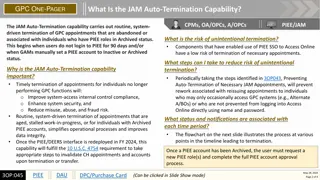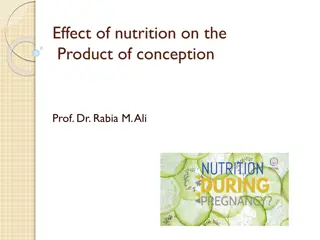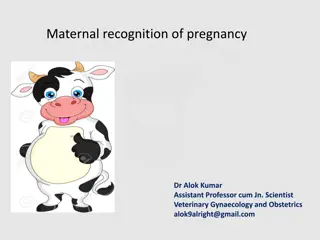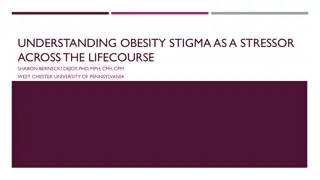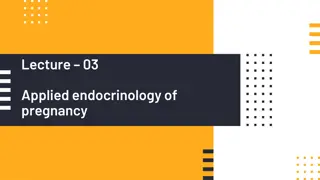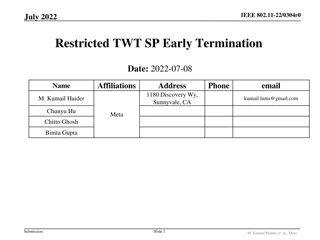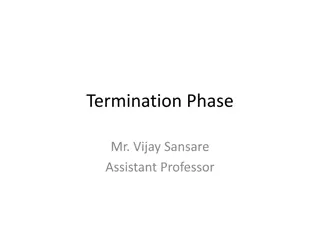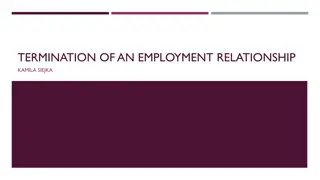Overview of Medical Termination of Pregnancy
Medical termination of pregnancy, also known as abortion, involves deliberate termination of a pregnancy before viability of the fetus. The process can be legal or illegal, depending on the country's laws. This overview covers the definition, the Medical Termination of Pregnancy Act of 1971 in India, legal aspects, indications for abortion, and methods for first-trimester termination.
Download Presentation

Please find below an Image/Link to download the presentation.
The content on the website is provided AS IS for your information and personal use only. It may not be sold, licensed, or shared on other websites without obtaining consent from the author.If you encounter any issues during the download, it is possible that the publisher has removed the file from their server.
You are allowed to download the files provided on this website for personal or commercial use, subject to the condition that they are used lawfully. All files are the property of their respective owners.
The content on the website is provided AS IS for your information and personal use only. It may not be sold, licensed, or shared on other websites without obtaining consent from the author.
E N D
Presentation Transcript
INTRODUCTION Medical termination of pregnancy is refers as the induction of abortion. The induction of abortionmay be legal & illegal. There are many countries in the globe where the abortion is not yet legalised. In india the abortion was legalised by medical terminationof pregnancy Act of 1971, &has been inforced in the april 1972.
DEFINITION Deliberatetermination of pregnancy either by the medical & surgical method before the viability of the fetus is called induction of abortion
MEDICAL TERMINATION OF PREGNANCY ACT 1971:- TheIndianabortion laws fallsundertheMedicalTerminationof Pregnancy (MTP) Act, which was enacted by the Indian Parliament in the year 1971 with the intention of reducing the incidence of illegal abortion and consequent maternalmortality and morbidity. The MTP Act came into effect from 1 April 1972 andwasamended intheyears 1975and 2002. Recently, the Supreme Court permitted a rape survivor to terminateherpregnancyat24weeks,which is beyond the permissible 20 weeks limit prescribed under the Medical Termination of Pregnancy Act,1971
LEGAL ABORTION :- - Termination isperformed by the medical practitioners(assisted in at least 25 mtp °ree in OBG)by theact. - Termination isdoneattheplaceapproved undertheact. - Terminationdoneforcondition &withinthegestationweek prescribed by theact. - Theabortion hastobereported tothedirectorof health service of thestate.
INDICATION Women whose physical and/or mental healthwere endangered by thepregnancy Womenfacing thebirthof apotentially handicappedor malformedchild Rape Pregnanciesinunmarriedgirlsundertheageof eighteen withtheconsentof aguardian Pregnanciesthatarearesultof failureinsterilisation
FIRST TRIMESTER TERMINATION OF PREGNANCY METHODS OF FIRST TRIMESTERABORTION: Mifepristone (RU-486) and Misoprostol Mifepristone(200mg) an analog of progestin (norethindrone) actsasanantagonist, blocking theeffect of natural progesterone. Addition of low dose prostaglandins (800mg) (PGE1) improves the efficiency of first trimester abortion. It is effectiveupto63 daysand is highlysuccessfulwhenused within 49 days ofgestation.
. Methotrexate and Misoprostol Methotrexate 50 mg/m2 IM (before 56 days of gestation) followed by 7 days later misoprostol800 g vaginally is highlyeffective. Misoprostol may have to be repeated after 24hours if it fails. Methotrexate and misoprostol regimen isless expensive but takes longer time than Mifepristone andMisoprostol.
SURGICAL METHODS OF FIRST TRIMESTER ABORTION: . MENSTRUALREGULATION: Itistheaspirationof theendometrial cavitywithin 14days of missed period in awoman with previous normal cycle. Theoperation isdoneasanoutpatientoranoffice procedure It is done with asepticprecautions. After introducing the posterior vaginal speculum,the cervix is steadied with an Allisforceps.
Cervix maybegentlydilated using 4or5 mmsizedilators. Thecannulaisrotated, pushed inandoutwithgentlestrokes. . . Theoperatorshould examinetheaspirated tissue byfloating itina clearplasticdishoveralightsource. Thiswill helptodetectfailedabortion, molarpregnancyorectopic pregnancy. 5 6 mm suction cannula (Karman s) is then inserted and attachedto the 50 mL syringe forsuction. Theprocedureiscontraindicated inthepresenceof pelvic inflammation.
A B Menstrual regulation equipment (A)Syringe (B) Plasticcannulawithwhistletipused insuctionevacuation
VACUUM ASPIRATION (MVA/EVA): Doneupto12 weekswith minimalcervicaldilatation It isperformedasanoutpatientprocedureusingaplasticdisposable cannula (upto12 mmsize)anda 60 mLplastic(doublevalve) syringe. Karman s Itisquicker(15 minutes),effective(98 100%), lesstraumaticand saferthan dilatation, evacuation andcurettage. Theproceduremaybe manualvacuumaspiration(MVA)orelectricvacuum aspiration(EVA). Handoperateddoublevalveplasticsyringe isattached toacannula. Thecannulais inserted transcervically intotheuterusand thevacuum isactivated. A negative pressure of 660 mm Hg iscreated. Aspiration of the products of conception isdone
DILATATION AND EVACUATION (D+E) &( D+C) : Theoperationconsistsof dilatationof thecervixand evacuationof the product conception from theuterus PROCEDURE :- 1. Vaginal examination is done to note the size and position of the uterus and to note the state of cervix. USG should be performed when there is any doubt about the gestational age. 2. Posterior vaginal speculum is introduced and anassistant is asked to hold it. 3. Theanteriorlipof thecervixistobegrasped byanAllis forceps.
4. The cervix may have to be dilated with smaller size graduated metal dilators up toone size less than thatof the suctioncannula. Feeling of snap of theendocervix around thedilator is characteristic. Instead laminaria tent 12 hours before (osmoticdilator) or misoprostol (PGE1) 400 g given vaginally 3 hours priortosurgery produceseffectivedilatation. 5.Intravenous methargin 0.2 mg isadministered. 6.The appropriate suction cannula is fitted to the suction apparatus by a thick rubber or plastic tubing. The cannula is then introduced into the uterus,thetipistobeplaced in themiddleof theuterinecavity. 7.Thepressureof thesuction israised to400 600 mm Hg. Thecannula is moved up and down and rotated within the uterine cavity (360 ) with the pressure on. The suction bottle is inspected for the products of conceptionand blood loss.Thesuctionisregulated byafingerplacedover a holeatthebaseof thecannula .
. The end point of suction is denoted by: (a)No more material is being sucked out (b)Gripping of the cannula bythe contracting smaller sizeuterus (c)Appearance of bubbles in the cannulaor in the transparenttubing. 8. After being satisfied that the uterus is remaining firm, and there is minimal vaginal bleeding, the patient is brought down fromthetableafterplacingasterile vulval pad.
SECOND TRIMESTER TERMINATION OF PREGNANCY MEDICAL METHODS: PROSTAGLANDINS: Theyacton thecervixand the uterus. The PGE (dinoprostone, sulprostone, gemeprost, misoprostol)and PGF (carboprost) analogues are commonlyused PGEsare preferred as they have moreselectiveactionon the myometrium and less sideeffects.
1. Misoprostol (PGE1analogue) o 400 800 g of misoprostol givenvaginallyatan intervalof 3 4 hours is most effective as the bioavailability ishigh. o Alternatively, first dose of 600 g misoprostol given vaginally, then 200 g, orallyevery3 hoursarealsofoundoptimum. o Recently 400 g misoprostol isgivensublinguallyevery3 hours foramaximum of fivedoses. o Thisregimen hasgot100%success insecond trimesterabortion. 1. . Gemeprost (PGE1analogue): o 1 mgvaginalevery3 6 hours forfivedoses in 24 hours hasgotabout90% success. o The mean induction-abortion interval was 14 18hours.
1.Mifepristone andprostaglandins: oMifepristone 200 mg oral, followed 36 48 hours later bymisoprostol o800 g vaginal; then misoprostol 400 g oral every 3 hours for4 doses isused. oSuccess rate of abortion is 97% and median inductiondelivery interval is 6.5 hours. oPretreatment with mifepristone reduces the induction abortion interval significantly compared to use of misoprostolalone. 2. Prostaglandin F2 (carboprost):- -250mg IM every 3 hours fora maximum 100 dosecan beused
OXYTOCIN: Highdoseoxytocinasasingleagentcan beused forsecond trimesterabortion. , It is effective in 80% ofcases. Itcan beusedwith intravenousnormal salinealong withanyof themedications used either intra-amniotic or extra-amniotic space in an attempt to augment the abortionprocess. MODE OF ACTION: Myometrial oxytocin receptor concentration increases maximum(100-200 fold) during labour. Oxytocinacts throughreceptorandvoltage mediatedcalciumchannels to initiate myometrialcontractions.
SURGICAL METHODS: Itisdifficulttoterminatepregnancyinthesecond trimesterwithreasonablesafetyas in firsttrimester. Between 13 and 15weeks Dilatationand Evacuation inthemidtrimesteris lesscommonlydone. o Pregnanciesat 13 to14 menstrualweeksareevacuated. o Inall midtrimesterabortioncervical preparation mustbeused (WHO 1997) to make the process easy andsafe. o Intracervical tent (Laminariaosmoticdilator), mifepristoneormisoprostol areused as the cervical primingagents. o The procedure may need to be performed under ultrasound guidance to reduce the risk of complications. o Simultaneous use of oxytocin infusion isuseful.
Between 16 and 20 weeks: ---- Intra-amniotic ---- Extra-amniotic Intra-amniotic: Intra-amniotic instillation of hypertonic saline (20%) is lesscommonly used now. It is instilled through the abdominalroute. Mode of action: There is liberation of prostaglandins following necrosisof the amniotic epithelium and the decidua. This in turn excites uterine contractionand results intheexpulsionof thefetus. Procedure: Preliminaryamniocentesis isdone bya 15cm 18gaugeneedle. Theamountof salinetobeinstilled iscalculatedas numberof weeks of gestation multiplied by 10 mL. Theamountistobeinfusedslowlyattherateof 10 mL/min.
Extra-amniotic: Extra-amniotic instillation of 0.1% ethacrydinelactate done transcervically through a number 16 Foley scatheter Thecatheterispassed upthecervicalcanal forabout 10cmabovetheinternal os between the membranes and myometrium and the balloon is inflated (10 mL) withsaline. Itisremoved after4 hours. Thesuccessrateissimilartosaline instillation butis less hazardous. Itcan beused incasescontraindicated forsaline instillation. Stripping the membranes with liberation of prostaglandins from the decidua and dilatation of the cervix by the catheter are some of the known factors for initiationof theabortion.
HYSTEROTOMY Hysterotomy is an operative procedure of extracting the products of conception out of the womb before 28th weekby cutting through the anterior wall of theuterus. . Theoperation isusuallydonethrough theabdominal route. Theoperation israrelydonethesedays forthepurposeof MTP. Complications: I. Hemorrhage andshock II. Peritonitis III. Intestinalobstruction
COMPLICATION OF MTP :- IMMEDIATE: Injury to the cervix (cervicallacerations) uterine perforation during D andE Haemorrhage and shock due to trauma, incompleteabortion, atonic uterus or rarely coagulationfailure Thrombosis orembolism REMOTE: The complications are groupedinto: o Gynecological o Obstetrical
Gynecological complications include I. menstrual disturbances . II. chronic pelvicinflammation III. scar endometriosis(1%) Obstetrical complications include I. ectopic pregnancy (three-foldincrease) II. preterm labour III. dysmaturity, IV. ruptureuterus






